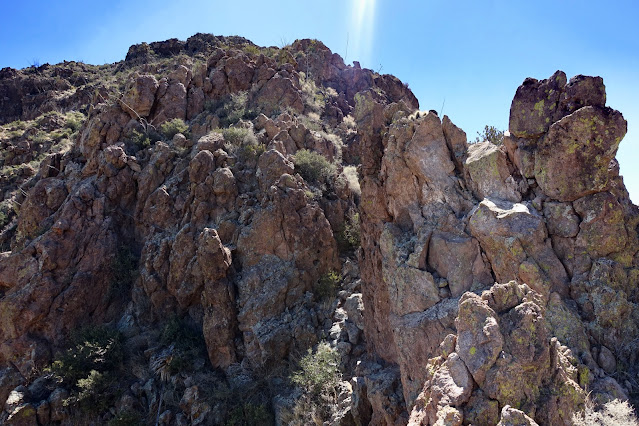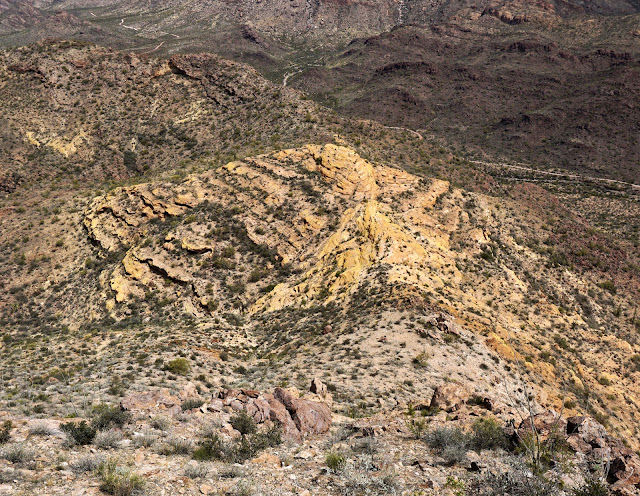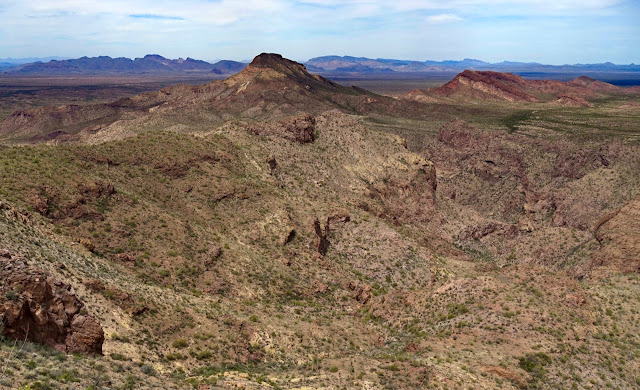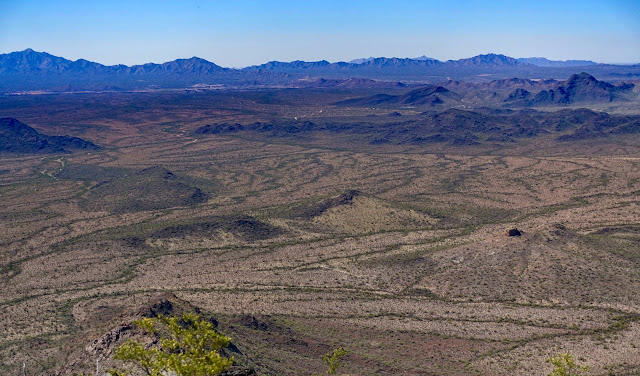Essence: Diaz Spire is among the compact triumvirate in the southern sector of the Ajo Range. Compared with the other peaks on the pinnacle-encrusted massif, the Spire looks the most intimidating but it is arguably the easiest to climb. Slopes are rather steep and footing is rough but there are no obstacles standing in the way of those who wish to claim this powerful monolith seen from places both high and low throughout the Monument. Visitation is rare. There are no guiding footprints or cairns and navigation is a serious challenge. The hike is within the Monument, administered by the National Park Service.
Travel: From the Visitor Center, cross AZ 85 and measure distance from the
beginning of the 21-mile, one-way Ajo Mountain Drive. Pass the Estes Canyon Picnic Area and Trailhead. Park on the left off the main road at a closed track at about 12.7 miles. The Ajo Mountain Drive guide lists this as Stop #14.
Fees and Camping: Consult the Monument website; entrance fees and the camping reservation system have changed repeatedly over the years.
Distance and Elevation Gain: 8.6 miles; 1,900 feet of climbing
Total Time: 5:30 to 7:30
Difficulty: Two-track, off-trail; navigation challenging; Class 2+; no exposure; dress defensively. Hike on a cool day and carry all the water you will need.
Map: Diaz Peak, Arizona 7.5' USGS Quad
Date Hiked: March 27, 2022
Personal Note: I've been hanging out and hiking in the Monument for three decades. On the eve of my 2022 birthday, my partner and I hatched a plan to climb Diaz Spire which struck us as being appropriately ultra cool. We didn't have the Diaz Peak quad and knew nothing about the route. Internet was poor in the campground but we managed to download a track. Inevitably this strategy (not good wilderness practice!) meant we were entering a mysterious world where our route questions were answered on the fly.
Quote: We don’t stop hiking because we grow old—we grow old because we stop hiking. Finis Mitchell
Flaming ocotillo torches mimic the evanescent flare of Diaz Spire as the sun settles down over the Twin Peaks Campground. (Thomas Holt Ward, photo)
Route: From Stop #14 on Ajo Mountain Drive, hike southeast on an old road to a T intersection and then bear east. At two miles leave the track and cross a ravine bearing east-southeast on the south side of Point 2,358', staying north of a small ridge capped with brilliant white stones. At 2,400 feet start up a broad ridge that arcs south to the saddle between Diaz Peak and Spire. Ascend west, flanking a major gendarme on its south. Return as you came. Note: The Diaz Peak quad has 20 foot contour intervals.
The orientation image below was taken from the highpoint of the Diablo Mountains the day prior. Diaz Peak, 4,024', is on the left with 1,501 feet of prominence. Diaz Spire is to its right with 362 feet of rise, followed by Peak 3,704' with 434 feet of lift. We erroneously assumed that we'd be hiking to the obvious Spire-Peak 3,704' saddle. Instead, the hike passes the low-slung hills in the foreground on the south/right and heads to the low ridge in the valley north/left of the peaks. It makes for Saddle 3,530' (unseen in this snap) between Diaz Peak and Diaz Spire.
From the parking pullout at elevation 2,150 feet, walk south on the road closed to vehicles. We surmised that the recent OHV tracks were associated with the Border Patrol. Plants were climax Sonoran: mature organ pipe cactus with multiple trunks, thick-stalked ocotillo, cane and chain fruit cholla, palo verde clusters, saguaro, jojoba, and creosote. The road drops into and out of a series of shallow and deep washes. Sure, you could wander around in the open desert but the road is simple, quick, and a navigational aid. Stay with it as it threads between Point 2,317' and Point 2,298'. It then tracks south of a small hill, 2,199'.
The road reaches a T intersection at 1.7 miles. Turn east/left and soon come alongside a trenched arroyo that carries water shed from the prominences in the vicinity of Sweetwater Pass. Leave the road and cross the drainage at a suitably shallow place at about 2.0 miles, shown. After no appreciable elevation gain, the ascent begins. Hike south-southeast, passing between another set of small hills, staying south of Point 2,358' and north of a tangled wash draining the basin north of the peaks.
The next landscape marker is a white-capped ridge, elevation 2,590 feet, image center-left. Pass northeast of it while making for the low ridge in the center of the basin. This is rough country--brushy with large rocks underfoot.
Start up the ridge at about 2,400 feet and stay on it as it arcs from southeast to south making for the saddle.
At last, the elusive Diaz Peak-Spire saddle comes into view, image-left. On the right is the east ridge of Diaz Spire beginning with the gendarme, two false summits, and the peak.
An outcrop straddles the ridge at 3,200 feet. Enjoy the Class 2+ scramble or flank the formation on the east.
The slope between the outcrop and saddle is steep and rubbly. (THW, photo)
Arrive on the saddle at 3.8 miles, 3,530 feet. Although there were no signs of recent passage this was clearly a migration pathway because the saddle was covered with empty black water bottles and assorted trash. It was a little disconcerting for we had heard tales of a hiker stumbling on smugglers on nearby Peak 3,704'. Diaz Spire is just a half mile west. But first, we were curious whether we could zip on up Diaz Peak.
We climbed just 100 feet before confronting a crux. This was going to be a project. We deeply wanted to climb the Spire and the day was in the 90s. So we left the peak for another day.
This image was shot as we returned to the saddle. We bypassed the initial outcrop on the north. Next, the sizeable, no-nonsence gendarme must be dealt with. The only through route is on its south/left side. However, we didn't know that and we tried the north side first. (THW, photo)
We were soon cliffed out on a thin precipice hanging out over a sweeping, vertical-walled amphitheater. We backed out, glad that we checked out this silent, private world. (THW, photo)
The slope on the south side of the resistant volcanic plug falls off steeply and some material is loose. Take your time.
The greatest hazard is teddybear cholla. Rock formations on the monolith are fascinating and vary widely from pebble breccia to welded tuff and silky smooth rhyolite.
Return to the ridge to conclude with a pleasant climb over a couple of knobs capped with basalt boulders.
Drawing close, Diaz Spire is surprisingly welcoming. Arrive on the relatively broad pile of boulders at 4.3 miles.
(THW, photo)
The peak register was placed in 1998 on a scrap of paper. Gerry and Jennifer Roach of Colorado guidebook fame left a formal sheet in 2006. Eight years passed until the register was signed again. I can only speculate that the Spire lives in the shadow of Diaz Peak, the highpoint of the Diaz threesome. Diaz Peak and Spire are named for Captain Melchior Diaz, Spanish conquistador and member of the Coronado Expedition 1539-1542.
This image looks back to Diaz Peak. The lands east of the peak are within the Tohono O'Odham Nation. (THW, photo)
I first climbed Mount Ajo in March of 2005 during a superbloom. I specifically recall looking over to Diaz Spire and figuring it was outside the realm of possibility. The most challenging mountains we have climbed in the range thus far are Peak 4,740' and its companion Point 4,700', seen below to the left of Mount Ajo.
In contrast, Tillotson Peak, seen here rising from the Valley of the Ajo, is a playful, half-day hike for people who love to mess around on boulders.
Even if you walk west until the arc starts to fall off into oblivion, you can't see down into the Spire-Peak 3,704' saddle. It is pure air (as a good spire should be) on all sides save the one that transported us to this wondrous and neglected sentinel.





































































